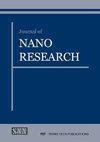磷酸锌纳米颗粒的合成及应用研究进展
IF 1
4区 材料科学
Q4 MATERIALS SCIENCE, MULTIDISCIPLINARY
引用次数: 0
摘要
纳米材料以其在人类文明中的迷人属性成为当今研究的热点。磷酸锌纳米颗粒(ZnPNPs)是一种无机材料,具有高热稳定性、低溶解度、生物相容性、无毒性和发光性能等特点。因此,研究人员对ZnPNPs在许多重要应用方面进行了大量的探索,如防腐色素、药物递送、抗菌和抗癌剂、生物催化剂、润滑剂添加剂、骨组织再生和从环境样品中去除有毒金属等。考虑到不同的应用潜力,目前主要通过沉淀法、声化学法和生物法制备形貌不同的ZnPNPs。ZnPNPs的表面性质随pH、温度、反应时间和底物浓度的不同而不同。在消除有毒化学物质和副产品方面,ZnPNPs的一步就地合成和简易合成程序以及更环保的合成方案比传统方法更有优势。此外,人工和天然聚合物修饰的ZnPNPs都可以提供更好的性能,例如更好的胶体稳定性,进一步功能化的选择,以及制备的杂化纳米复合颗粒在应用于目标应用时所需的生物相容性。此外,聚合物功能化ZnPNPs的体外和体内研究在生物技术和电化学领域都是一个有吸引力的研究课题。因此,本文对制备方法的最新进展进行了总结,为研究人员在提高ZnPNPs的形状选择性合成和应用潜力方面的未来方向提供了机会。本文章由计算机程序翻译,如有差异,请以英文原文为准。
Recent Progress in Synthesis and Applications of Zinc Phosphate Nanoparticles: A Review
Nowadays, nanomaterials have become the research hot topic by the virtue of their fascinating attributions in human civilization. Zinc phosphate nanoparticles (ZnPNPs), an inorganic material, possess some unique features, such as high thermal stability, low solubility in corrosive media, biocompatibility, non-toxicity and luminescence property. As a result, ZnPNPs have enormously been explored by researchers in many important applications, such as anticorrosion pigment, drug delivery, antibacterial as well as anticancer agents, biocatalyst, lubricant additives, regeneration of bone tissues and removal of toxic metal from the environmental samples, and so on. Considering diversified applications potential, morphologically different ZnPNPs have mainly been fabricated by precipitation, sonochemical and biological methods. The surface property of ZnPNPs differs with pH, temperature, reaction time, and substrate concentrations. One-step in situ and facile synthetic procedures, as well as greener synthesis protocols of ZnPNPs can be advantageous over conventional methods to eliminate toxic chemicals and by-products. In addition, both artificial and natural polymer-modified ZnPNPs would offer improved properties, such as better colloidal stability, option for further functionalization, and render desired biocompatibility of prepared hybrid nanocomposite particles in applying for targeted applications. Furthermore, both in vitro and in vivo studies of polymer functionalized ZnPNPs can be an attractive research topic in biotechnological and electrochemical fields. Therefore, the current review provides a summary of the recent progress on the fabrication methods, an opportunity for the future directions to the researchers in the improvement of shape-selective synthesis and application potentials of ZnPNPs.
求助全文
通过发布文献求助,成功后即可免费获取论文全文。
去求助
来源期刊

Journal of Nano Research
工程技术-材料科学:综合
CiteScore
2.40
自引率
5.90%
发文量
55
审稿时长
4 months
期刊介绍:
"Journal of Nano Research" (JNanoR) is a multidisciplinary journal, which publishes high quality scientific and engineering papers on all aspects of research in the area of nanoscience and nanotechnologies and wide practical application of achieved results.
"Journal of Nano Research" is one of the largest periodicals in the field of nanoscience and nanotechnologies. All papers are peer-reviewed and edited.
Authors retain the right to publish an extended and significantly updated version in another periodical.
 求助内容:
求助内容: 应助结果提醒方式:
应助结果提醒方式:


